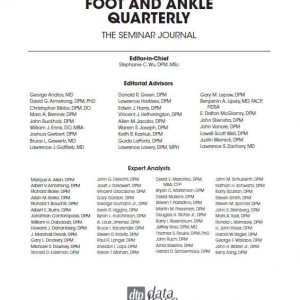31-2: Clinical Pharmacology for the Lower Extremity Professional: An Update
$88.00
Editorial
In her 1978 work of critical theory, Illness as a Metaphor, Susan Sontag offered the following: “Everyone who is born holds dual citizenship, in the kingdom of the well and the kingdom of the sick.”
It is essential that the lower extremity provider, when making decisions regarding which medications to prescribe, employs the knowledge of pharmacology, adverse medication effects as well as drug interactions. Physicians are trained to realize that medication response is not the same in every patient. It must be acknowledged that pharmacological regimens do not exist in a vacuum. The science of pharmacology and pharmaceutical manufacturing continually evolves and advances. It is crucial that healthcare providers select agents of therapy based on up-to-date information.
In this issue’s feature article, I included the phrase “Veneni dextera dextrae Tempus” — Latin for “Right drug right time” — as a metaphor for the available clinical-based evidence within the evolving science of pharmacology. It is imperative that clinicians familiarize themselves and stay updated on how given medications may act differently depending on patient factors and pathophysiology. For this reason, the feature article encompasses a review of tools to assist in prescribing newer medications with an exploration of critical elements that affect patient response.
This issue’s abstracts and commentaries pertain to updated relevant pharmacology issues, some that may be controversial in the context of evolving ideology for enhancing medication response while mitigating negative interactions.
The first audio lecture is centered on avoiding drug injury and responsibilities of the lower extremity physician in detailing medical and legal aspects that the lower extremity specialist should consider so to avoid drug-induced injury. The second audio presentation focuses on new medications that have reshaped treatment options in our realm of care. This lecture explores medications that have recently come to market, noting each agent’s pharmacology, directions for use, adverse drug profile and cost to patients. This issue reviews many of the advances and updates regarding the changing viewpoints of pharmacotherapy, so that the practicing foot and ankle specialist can select appropriate pharmacological agents for their diverse patient population with confidence.
Robert G. Smith, DPM, MSc, RPh
Description
In This Issue:
- FEATURE ARTICLE: A Prescription for Veneni dextera dextrae Tempus: A Clinical Pharmacology Update
Robert G. Smith, DPM, MSc, RPh - CONDENSATIONS and COMMENTARIES
- Pharmacogenomics
Commentary by Robert G. Smith, DPM, MSc, RPh - Principles and Practice of Antibiotic Stewardship in the Management of Diabetic Foot Infections
Commentary by Warren Joseph, DPM - Venous Thromboembolism and Bleeding Adverse Events in Lower Leg, Ankle and Foot Orthopaedic Surgery with and without Anticoagulants 87
Commentary by Duane J. Ehredt Jr., DPM - Safety of Dermatologic Medications in Pregnancy and Lactation: Part I 90
Commentary by Robert G. Smith, DPM, MSc, RPh - The Implications of Biologic Therapy for Elective Foot and Ankle Surgery in Patients with Rheumatoid Arthritis 93
Commentary by Robert G. Smith, DPM, MSc, RPh - Cannabinoids: Current and Future Options to Treat Chronic and Chemotherapy-Induced Neuropathic Pain 96
Commentary by Robert G. Smith, DPM, MSc, RPh - Evaluation and Peri-Operative Management of the Diabetic Patient 100
Commentary by Robert G. Smith, DPM, MSc, RPh - Medicines Management Activity with Physiotherapy and Podiatry: A Systematic Mixed Studies Review 103
Commentary by James B. McGuire PT, DPM - Prevention of Infection in Foot and Ankle Surgery 106
Commentary by Robert G. Smith, DPM, MSc, RPh - Update on Current Approaches to Diagnosis and Treatment of Onychomycosis 109
Commentary by Annette Joyce, DPM - Morbidity, Mortality and Management of Methicillin-Resistant S.aureus Bacteremia in the USA: Update on Antibacterial Choices and Understanding 112
Commentary by Robert G. Smith, DPM, MSc, RPh - A Contemporary Medicolegal Analysis of Injury Related to Peripheral Nerve Blocks 116
Commentary by Robert G. Smith, DPM, MSc, RPh - Antimicrobial Stewardship Opportunities among Inpatients with Diabetic Foot Infections: Microbiology Results from a Tertiary Hospital Multidisciplinary Unit 119
Commentary by Warren Joseph, DPM
- Pharmacogenomics
- AUDIO LECTURE 1: Avoiding Drug Injury: Responsibilities of the Lower Extremity Physician 122
Robert G. Smith, DPM, MSc, RPh - AUDIO LECTURE 2: New Medications: Reshaping Treatment Options for the Lower Extremity Physician 124
Robert G. Smith, DPM, MSc, RPh - CONTINUING EDUCATION QUESTIONNAIRE


